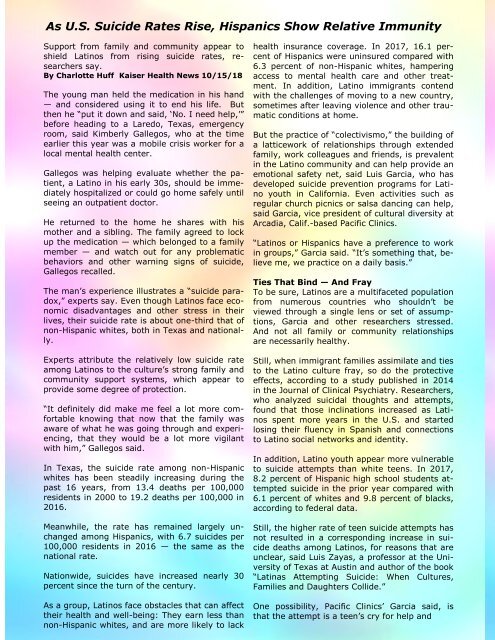You also want an ePaper? Increase the reach of your titles
YUMPU automatically turns print PDFs into web optimized ePapers that Google loves.
As U.S. Suicide Rates Rise, Hispanics Show Relative Immunity<br />
Support from family and community appear to<br />
shield Latinos from rising suicide rates, researchers<br />
say.<br />
By Charlotte Huff Kaiser Health News 10/15/18<br />
The young man held the medication in his hand<br />
— and considered using it to end his life. But<br />
then he “put it down and said, ‘No. I need help,’”<br />
before heading to a Laredo, Texas, emergency<br />
room, said Kimberly Gallegos, who at the time<br />
earlier this year was a mobile crisis worker for a<br />
local mental health center.<br />
Gallegos was helping evaluate whether the patient,<br />
a Latino in his early 30s, should be immediately<br />
hospitalized or could go home safely until<br />
seeing an outpatient doctor.<br />
He returned to the home he shares with his<br />
mother and a sibling. The family agreed to lock<br />
up the medication — which belonged to a family<br />
member — and watch out for any problematic<br />
behaviors and other warning signs of suicide,<br />
Gallegos recalled.<br />
The man’s experience illustrates a “suicide paradox,”<br />
experts say. Even though Latinos face economic<br />
disadvantages and other stress in their<br />
lives, their suicide rate is about one-third that of<br />
non-Hispanic whites, both in Texas and nationally.<br />
Experts attribute the relatively low suicide rate<br />
among Latinos to the culture’s strong family and<br />
community support systems, which appear to<br />
provide some degree of protection.<br />
“It definitely did make me feel a lot more comfortable<br />
knowing that now that the family was<br />
aware of what he was going through and experiencing,<br />
that they would be a lot more vigilant<br />
with him,” Gallegos said.<br />
In Texas, the suicide rate among non-Hispanic<br />
whites has been steadily increasing during the<br />
past 16 years, from 13.4 deaths per 100,000<br />
residents in 2000 to 19.2 deaths per 100,000 in<br />
2016.<br />
Meanwhile, the rate has remained largely unchanged<br />
among Hispanics, with 6.7 suicides per<br />
100,000 residents in 2016 — the same as the<br />
national rate.<br />
Nationwide, suicides have increased nearly 30<br />
percent since the turn of the century.<br />
As a group, Latinos face obstacles that can affect<br />
their health and well-being: They earn less than<br />
non-Hispanic whites, and are more likely to lack<br />
health insurance coverage. In 2017, 16.1 percent<br />
of Hispanics were uninsured compared with<br />
6.3 percent of non-Hispanic whites, hampering<br />
access to mental health care and other treatment.<br />
In addition, Latino immigrants contend<br />
with the challenges of moving to a new country,<br />
sometimes after leaving violence and other traumatic<br />
conditions at home.<br />
But the practice of “colectivismo,” the building of<br />
a latticework of relationships through extended<br />
family, work colleagues and friends, is prevalent<br />
in the Latino community and can help provide an<br />
emotional safety net, said Luis Garcia, who has<br />
developed suicide prevention programs for Latino<br />
youth in California. Even activities such as<br />
regular church picnics or salsa dancing can help,<br />
said Garcia, vice president of cultural diversity at<br />
Arcadia, Calif.-based Pacific Clinics.<br />
“Latinos or Hispanics have a preference to work<br />
in groups,” Garcia said. “It’s something that, believe<br />
me, we practice on a daily basis.”<br />
Ties That Bind — And Fray<br />
To be sure, Latinos are a multifaceted population<br />
from numerous countries who shouldn’t be<br />
viewed through a single lens or set of assumptions,<br />
Garcia and other researchers stressed.<br />
And not all family or community relationships<br />
are necessarily healthy.<br />
Still, when immigrant families assimilate and ties<br />
to the Latino culture fray, so do the protective<br />
effects, according to a study published in 2014<br />
in the Journal of Clinical Psychiatry. Researchers,<br />
who analyzed suicidal thoughts and attempts,<br />
found that those inclinations increased as Latinos<br />
spent more years in the U.S. and started<br />
losing their fluency in Spanish and connections<br />
to Latino social networks and identity.<br />
In addition, Latino youth appear more vulnerable<br />
to suicide attempts than white teens. In 2017,<br />
8.2 percent of Hispanic high school students attempted<br />
suicide in the prior year compared with<br />
6.1 percent of whites and 9.8 percent of blacks,<br />
according to federal data.<br />
Still, the higher rate of teen suicide attempts has<br />
not resulted in a corresponding increase in suicide<br />
deaths among Latinos, for reasons that are<br />
unclear, said Luis Zayas, a professor at the University<br />
of Texas at Austin and author of the book<br />
“Latinas Attempting Suicide: When Cultures,<br />
Families and Daughters Collide.”<br />
One possibility, Pacific Clinics’ Garcia said, is<br />
that the attempt is a teen’s cry for help and


